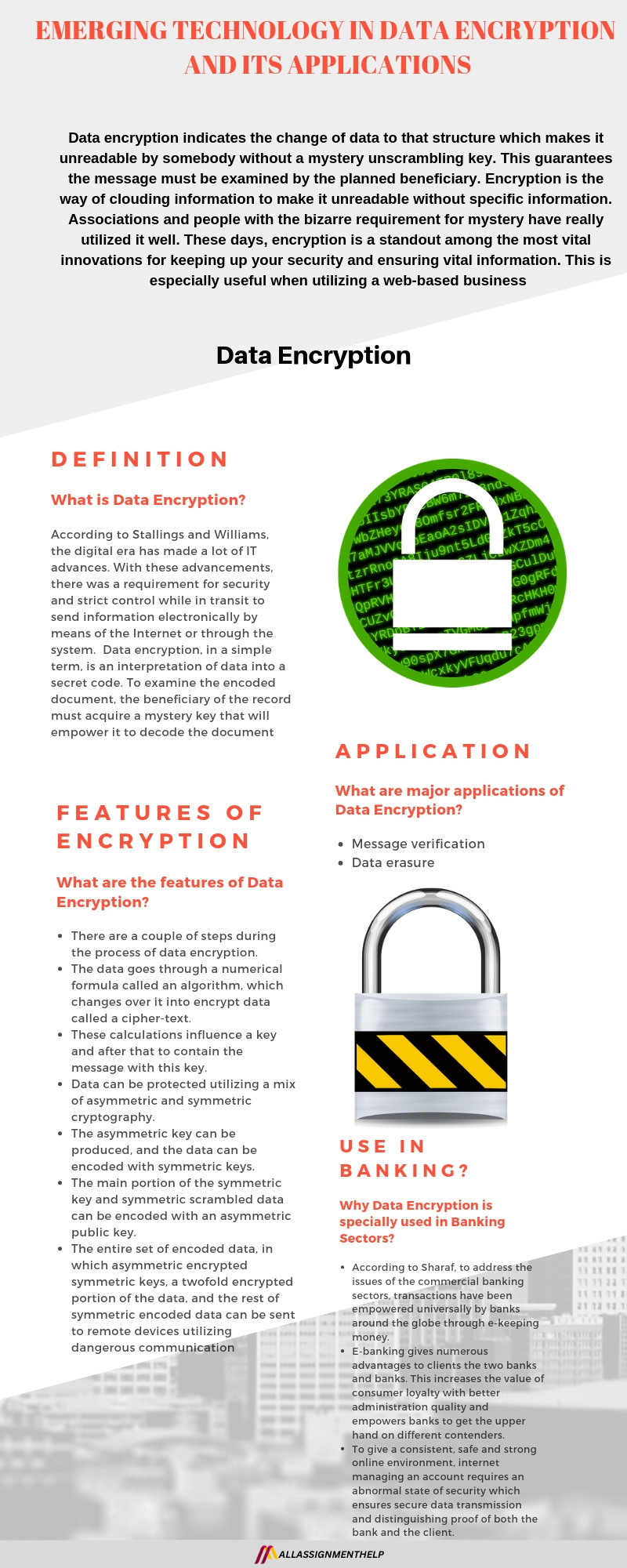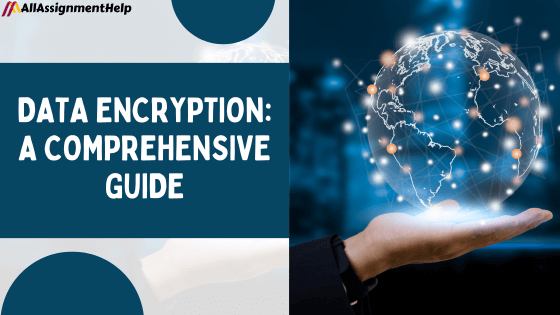Table of Contents
In the current digital era, data has emerged as a vital component of both organizations and individuals. Thus, the security of our data is crucial, especially when it comes to sensitive financial information, personal data, and intellectual property. Data encryption is a potent method that is essential for protecting our information from unauthorized access and potential cyber threats. When data is encrypted, it is transformed from plaintext, which can be read into ciphertext, which must be retrieved using a special cryptographic key.
Nearly everything on the internet has been encrypted for some time. Therefore, it is impossible to overestimate the importance of data encryption as a tool for ensuring data integrity. As a student of computer science, you should make yourself familiar with data encryption, its functions, and other important aspects. However, don’t worry! One of our experts at All Assignment Help has created this blog for you to help you know everything about the encryption of data in one place. So, without much further ado, let’s jump into the world of data encryption.
What is Data Encryption?
Data encryption transforms data from a readable plaintext format into ciphertext, an unintelligible encoded format. Data that has been encrypted cannot be viewed or used by users or programs until it has been decrypted. Since the decryption key is confidential, it needs to be secured against unauthorized access.
Encryption is the method involved with changing over information into an unusable structure and doesn’t itself quit hacking or information theft. Instead, it prohibits the usage of stolen content due to the fact that the hacker or content thief cannot view it in plaintext format.
With the introduction to computers and the internet, there has been a rise in cybercrime. Therefore, everyone who uses the internet should be familiar with fundamental encryption mechanisms and how to apply them.
What Must Be Encrypted?
Encryption should be used for all digital transmissions and storage devices that carry sensitive information and exit the registry network’s security perimeter. This comprises:
- Backups of private information
- Uploaded data files or email (or other) communications
- Portable storage (CDs, external drives, USB flash drives, tape backups, laptops)
- On-server databases
Read Here: Data security and cyber threats
Why Is Data Encryption Necessary?
Data encryption is necessary for several reasons. It plays an important role in safeguarding our sensitive data while ensuring data security. However, if you still wanted to know why organizations use this technique, you should read below:
Security
Encryption shields data from information breaks, whether the information is very still or on the way. Furthermore, encryption enables parties to interact without worrying about data breaches and helps safeguard data from harmful actions like man-in-the-middle assaults.
Authentication
Public key encryption demonstrates that the origin server of a website actually does own the private key, demonstrating that it was rightfully given an SSL certificate. This is a crucial characteristic in a world filled with scam websites.
Privacy
The use of encryption ensures that only the intended receiver or data owner may access or read communications or data. This security precaution stops internet service providers, spammers, fraudsters, hackers, and even governmental entities from reading and accessing personal data.
Regulatory Conformity
Many sectors of the economy and government agencies have regulations in place requiring businesses that handle customers’ personal data to maintain that data encrypted. HIPAA, PCI-DSS, and the GDPR are a few examples of the legal and compliance requirements that forbid encryption.
Data encryption is necessary for modern data security. It safeguards data confidentiality and protects it from threats. Additionally, it also builds networking and collaboration between users and customers.

Types of Data Encryption Techniques
There are several different encryption techniques since there are many distinct types of data and numerous security use cases. Data encryption techniques may be roughly divided into two categories: symmetric data encryption and asymmetric data encryption.
Symmetric Encryption
The term “private key cryptography” also refers to symmetric encryption. When symmetrical encryption techniques are utilized, a single secret key is utilized to encrypt the plaintext and decipher the ciphertext. Furthermore, the key, which may only be used by authorized recipients, is private to both the sender and the recipient.
A few popular symmetric encryption techniques are:
- Advanced Encryption Standard (AES)
- Data Encryption Standard (DES)
- Triple DES (TDES)
- Twofish
Asymmetric Encryption
Asymmetric Encryption is also known as public key cryptography. There are two keys utilized in asymmetric encryption: a public key and a private key. Both the encrypting and decrypting operations require different keys:
- As the name implies, the public key is either made publically available or given to authorized recipients.
- A corresponding private key is required for data that has been encrypted using a public key. With this method, the data cannot be decrypted using the same public key.
However, understanding these two techniques is not a child’s play. You might need help from an expert who is proficient in Cyber Security. You can take online CyberSecurity assignment help from professionals who will help you throughout your journey of data encryption study. They will help you with your assignment writing as well.
Is it Possible to Hack Encrypted Data?
In a nutshell, yes, encrypted data may be hacked. Attackers can breach data encryption systems in a variety of ways:
Forceful assaults
Attackers often employ a random key generation process to attempt to crack encryption. The size of the key has a direct impact on the likelihood of success. For this reason, the majority of encryption standards call for the usage of 256-bit encryption keys. However, some encryption methods employ weak ciphers that are subject to brute-force assaults.
Endpoint devices with malware
Many endpoint devices include encryption technologies like whole disc encryption. An endpoint device can be taken over by an attacker using malware. Furthermore, they can then use the device’s keys to decrypt the data.
Cryptanalysis
This is also known as codebreaking or cryptography analysis. Attackers utilize this method to obtain data by identifying a flaw in the cipher itself. Breaking cryptographic codes and ciphers is both an art and a science that enables one to access protected data without authorization or to decipher the original plaintext.
Attacks using social engineering
Using phishing or other social engineering techniques to deceive a privileged person into revealing the key is likely the simplest approach to breach encrypted data.
Insider threats
The risk that a person with access will turn on the organization and exploit their privileges to steal data poses a serious threat to encrypted data. Users that are careless with security protocols are another source of insider dangers.
Even with these dangers, data encryption is a reliable and robust security tool. However, given the likelihood that encryption will be broken, it must be seen as an additional layer of security and not the sole one that businesses utilize to safeguard their data.
Also Read: Data Communication: A Connectivity Method between Two Entities
Standard Operating Procedures for Data Encryption
Data encryption is one of the finest ways to protect the data in a company. However, the key to good encryption is in the planning and implementation. Below, we have listed some of the best standard operating procedures to ensure the data encryption methods and processes are as efficient as they can be.
Set up the Security Needs
Any encryption plan must begin with a thorough analysis of the overall security environment of the business. It’s crucial to evaluate the present security demands before investing in a solution because encryption solutions differ in their level of strength and processing power.
You can assess the level of security by:
- Do a threat assessment to find any system vulnerabilities.
- Review authoritative resources, such as recognized cybersecurity frameworks.
Data Classification
It might be anything, such as client information, financial information, account information for the firm, or even confidential information on which the organization depends. After that, you may group each kind of data according to:
- Its sensitivity
- How and if it is controlled
- How frequently it is used and referred to
There are chances that you might get stuck at this stage. However, taking assignment writing services online from a reliable service provider can help you get out of trouble and help you with the classification of data in a better way.
Select the Appropriate Encryption Method
After determining your data priority and security demands, you may hunt for data encryption options that suit your requirements. However, you will probably need to install a variety of encryption methods and approaches to safeguard various types of data in the databases, files, and apps.
Moreover, you can data encryption technologies in addition to general security solutions like email security platforms, cloud security software, and payment gateways since these can also encrypt data and offer additional degrees of protection.
Think About Any Deployment Challenges
For every firm, expanding upon and reworking current security procedures is a significant adjustment. As a result, it’s critical to prepare for any potential issues, such as those that may result from the integration of data encryption technologies with legacy systems and application back-ends.
Understand the Restrictions of Data Encryption
Encryption is used to stop unauthorized access to sensitive data. But, the company still needs more cybersecurity measures to deter hackers. These include VPNs, endpoint security tools, and firewalls. Integrating an encryption plan into an established cybersecurity strategy should be simple.
Any organization must have an effective data encryption plan as a security safeguard. As we have seen, there are risks involved. Encryption algorithms and approaches must advance as computer systems continue to advance and cyberattacks get more advanced.
The Future of Data Encryption
The business is promoting encryption in a number of ways. Several efforts are being undertaken to increase key sizes to avoid brute-force decoding. Moreover, other initiatives are looking at revolutionary cryptographic techniques.
The problem is that on conventional computer systems, the majority of quantum-safe algorithms perform poorly. The industry is focusing on creating accelerators to speed up algorithms on x86 platforms to solve this problem.
Furthermore, the intriguing concept of homomorphic encryption enables users to do calculations on encrypted material without first having to decode it. As a result, an analyst who needs to do so can do so without needing to ask a higher-level analyst for permission.
However, there are many online courses available in which students can enroll themselves for advancing their knowledge about the world of data encryption. These courses are short-term and long-term and provide students with valuable insights about encryption. Also, we know that it is not possible for students to attend classes with full efficiency. There might be a situation when you need someone who can take my online class for me. In such a case, you can hire an expert online to help you with your online data encryption classes.
FAQs
| Q: How does data encryption work? A: Since the raw data is in plain language, it is readable. The data from ‘Hi!’ is then scrambled before being transferred using encryption methods. “How are you doing?” to “A#$Y&%($Y#%Y%.” The receiver takes this data after it has been communicated, decrypts it, and displays the result visually as plain text. |
| Q: Which are the four fundamental types of data encryption systems? A: The four fundamental types of data encryption systems are Triple DES, Blowfish, Advanced Encryption Standard (AES), and Rivest-Shamir-Adleman (RSA). |
